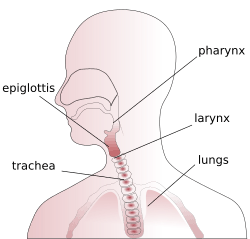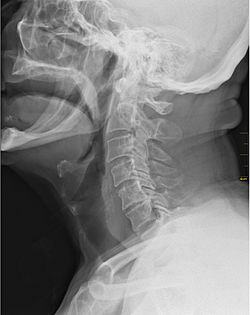Throat facts for kids
Quick facts for kids Throat |
|
|---|---|
 |
|
| The human throat. | |
 |
|
| X-ray showing the throat, seen as a dark band to the front of the spine. | |
| Latin | gula jugulum |
Your throat is an important part of your body. It's like a busy highway inside your neck! It connects your mouth and nose to your stomach and lungs. This means your throat handles both the food you eat and the air you breathe.
When you eat, food travels down your throat after you chew it. Drinks like water also go through your throat to your stomach. At the same time, air moves through your throat to your lungs. Your throat also helps you speak and sing!
Contents
What is the Throat?
The throat is a tube-like structure located in your neck. It starts behind your nose and mouth and goes down towards your chest. It's a key part of both your digestive and respiratory systems.
Your throat has several important jobs. It makes sure food goes to your stomach and air goes to your lungs. It also protects your airways from food and helps you make sounds.
Parts of Your Throat
Your throat isn't just one simple tube. It's made of several parts, each with a special role. Understanding these parts helps you see how amazing your body is.
The Pharynx: Your Food and Airway
The pharynx is the main part of your throat. It's a muscular tube that starts behind your nose and mouth. It acts as a pathway for both food and air. The pharynx is divided into three sections:
- The nasopharynx is the upper part, behind your nose. Air passes through here.
- The oropharynx is the middle part, behind your mouth. Both air and food pass through here.
- The laryngopharynx is the lower part, just above your voice box. This is where the path for food and air splits.
The Larynx: Your Voice Box
The larynx, often called your voice box, is located at the front of your neck. It's a small, hollow organ made of cartilage. Its main job is to help you speak and sing. Inside the larynx are your vocal cords.
The larynx also has a special flap called the epiglottis. This flap acts like a lid. When you swallow, the epiglottis closes over your windpipe. This stops food and drink from going into your lungs, which would make you choke.
The Esophagus: Food Tube
The esophagus is a muscular tube that carries food and liquids from your throat to your stomach. It's part of your digestive system. When you swallow, muscles in your esophagus push the food down in a wave-like motion. This motion is called peristalsis.
The Trachea: Your Windpipe
The trachea, also known as your windpipe, is a tube that carries air from your throat to your lungs. It's part of your respiratory system. The trachea is made of strong rings of cartilage. These rings keep the tube open so you can always breathe easily.
How Your Throat Works
Your throat is constantly working, even when you don't notice it. It performs several vital actions to keep you healthy and alive.
Swallowing Food and Drink
Swallowing is a complex process that your throat handles perfectly. When you chew food, it mixes with saliva to form a soft ball called a bolus. Your tongue then pushes this bolus to the back of your throat.
As you swallow, the epiglottis quickly closes over your windpipe. This sends the food down your esophagus and prevents it from entering your lungs. Muscles in your esophagus then push the food towards your stomach.
Breathing Air
Breathing is something you do without thinking, thanks to your throat. Air enters your body through your nose or mouth. It then travels through your pharynx and larynx into your trachea. From the trachea, air goes into your lungs.
Your throat ensures a clear path for air to reach your lungs. It also helps to warm and moisten the air you breathe.
Making Sounds
Your throat is essential for making sounds, including talking, singing, and shouting. This happens in your larynx, or voice box. When you speak, air from your lungs passes through your vocal cords.
Your vocal cords are two small bands of muscle. As air passes over them, they vibrate. These vibrations create sound. You can change the pitch and volume of your voice by tightening or relaxing your vocal cords.
Keeping Your Throat Healthy
Taking care of your throat is important for your overall health. Here are some tips:
- Drink plenty of water to keep your throat moist.
- Avoid shouting or straining your voice too much.
- Wash your hands often to prevent colds and infections.
- If you have a sore throat, rest your voice and drink warm liquids.
See also
 In Spanish: Garganta para niños
In Spanish: Garganta para niños

